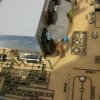Had one of two 15amp 250VP ceramic fuses blow on the power board. Checked over things visually for bad caps or burn marks and saw nothing. I replaced both of the fuses with new ones and tried plugging it back in and both new fuses blew immediately.
Next I pulled the power board to have a look at the back side and noticed an arc mark on the metal panel behind the board. Located the spot on the board and took a couple of pictures of the front and back. Not sure if the heat sink is shorting across the PCB where the contacts are? There is continuity across the screws holding it to the clips as well.


Next I pulled the power board to have a look at the back side and noticed an arc mark on the metal panel behind the board. Located the spot on the board and took a couple of pictures of the front and back. Not sure if the heat sink is shorting across the PCB where the contacts are? There is continuity across the screws holding it to the clips as well.


